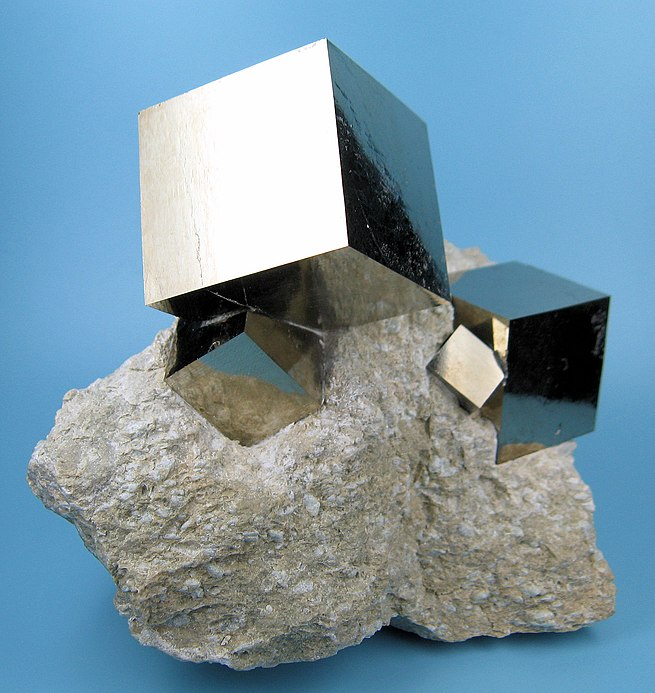
-
Pyrite
The mineral pyrite (), or iron pyrite, also known as fool’s gold, is an iron sulfide with the chemical formula FeS2 (iron(II) disulfide). Pyrite is considered the most common form of sulfide minerals.
Pyrite’s metallic luster and pale brass-yellow hue give it a superficial resemblance to gold, hence the well-known nickname of fool’s gold. The color has also led to the nicknames brass, brazzle, and Brazil, primarily used to refer to pyrite found in coal.The name pyrite is derived from the Greek πυρίτης (pyritēs), “of fire” or “in fire”, in turn from πύρ (pyr), “fire”. In ancient Roman times, this name was applied to several types of stone that would create sparks when struck against steel; Pliny the Elder described one of them as being brassy, almost certainly a reference to what we now call pyrite.By Georgius Agricola’s time, c. 1550, the term had become a generic term for all of the sulfide minerals.
Pyrite is usually found associated with other sulfides or oxides in quartz veins, sedimentary rock, and metamorphic rock, as well as in coal beds and as a replacement mineral in fossils, but has also been identified in the sclerites of scaly-foot gastropods. Despite being nicknamed fool’s gold, pyrite is sometimes found in association with small quantities of gold. A substantial proportion of the gold is “invisible gold” incorporated into the pyrite (see Carlin-type gold deposit). It has been suggested that the presence of both gold and arsenic is a case of coupled substitution but as of 1997 the chemical state of the gold remained controversial.
-
Chalcopyrite
Chalcopyrite ( KAL-ko-PY-ryt) is a copper iron sulfide mineral that crystallizes in the tetragonal system. It has the chemical formula CuFeS2. It has a brassy to golden yellow color and a hardness of 3.5 to 4 on the Mohs scale. Its streak is diagnostic as green tinged black.
On exposure to air, chalcopyrite tarnishes to a variety of oxides, hydroxides, and sulfates. Associated copper minerals include the sulfides bornite (Cu5FeS4), chalcocite (Cu2S), covellite (CuS), digenite (Cu9S5); carbonates such as malachite and azurite, and rarely oxides such as cuprite (Cu2O). Chalcopyrite is rarely found in association with native copper.
-
Pyrite (noun)
The common mineral iron disulfide (FeS2), of a pale brass-yellow color and brilliant metallic luster, crystallizing in the isometric system.
-
Pyrite (noun)
(usually as a plural: pyrites) Any metallic-looking sulphide, such as the above, which is the most common.
-
Pyrite (noun)
(usually as a plural: pyrites) Any metal dichalcogenide that is isostructural to the common mineral.
“Copper diselenide can occur both as a marcasite and a pyrite.”
-
Chalcopyrite (noun)
A yellow CuFeS2.
